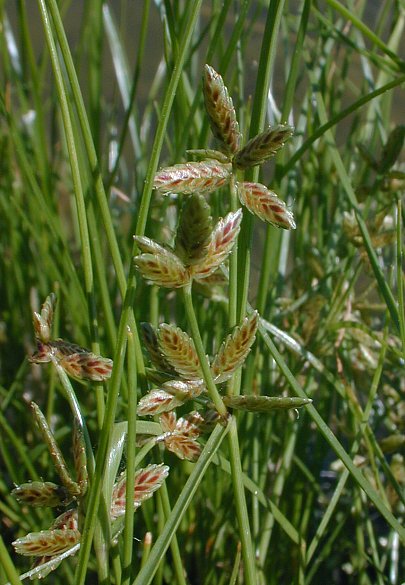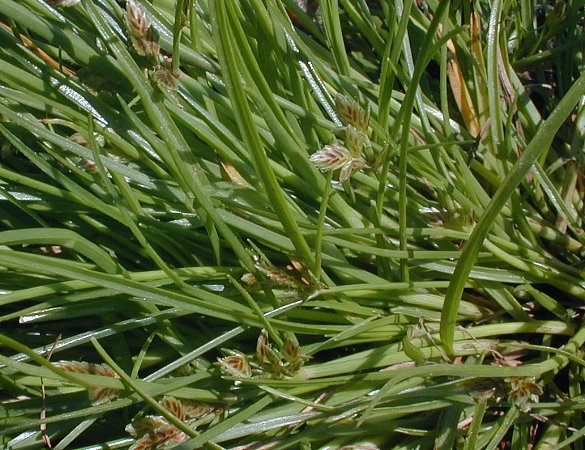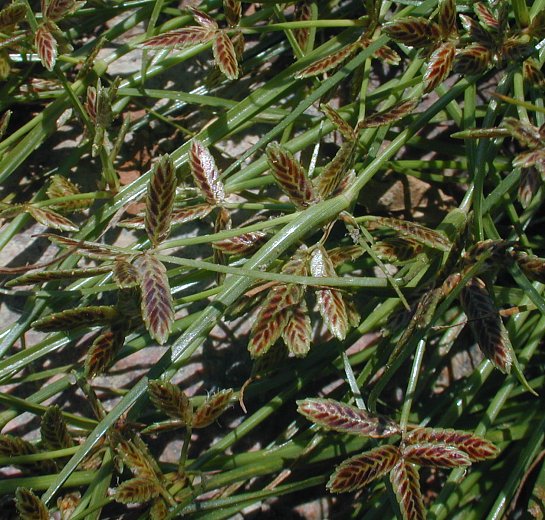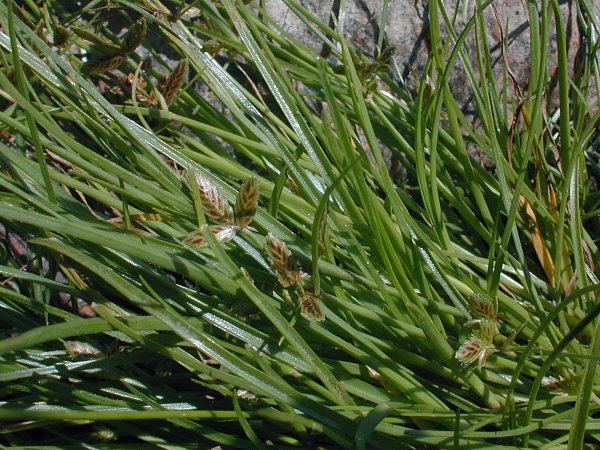Description: This flatsedge is a summer annual up to 10" tall. Its culms are sprawling to erect and unbranched; they are up to 8" long, medium or olive green, 3-angled, and glabrous, becoming brownish at the base. During the blooming period, there are 1-2 alternate leaves toward the base of each culm. These leaves are up to 4" long and 2.5 mm. across; they are medium or olive green, narrowly linear, and glabrous. The leaves are often folded upward along their central veins. The withered remains of older leaves may persist at the bases of culms. Each fertile culm terminates in an inflorescence consisting of one or more flowering spikes. Some spikes may be sessile, while others have short stalks (rays) up to 1½" long. At the base of the inflorescence, there are 2-3 leafy bracts up to 4" long. These bracts resemble the leaves; they are highly variable in size and ascending to widely spreading.

Each spike consists of 2-7 flattened spikelets that are clustered together, while each spikelet consists of 8-18 flowers and their scales. The floral scales of each spikelet are arranged in 2 columnar ranks; they are ascending and closely appressed together. Each spikelet is about 6-12 mm. (¼-½") long and flattened-oblongoid in shape; its floral scales are shiny purplish or reddish brown, except along the margins, where they are pale green or yellow. In addition to its floral scale, each flower has an ovary with a bipartite style and 2-3 stamens. The deciduous styles of these flowers are either enclosed by the scales, or they are barely exerted (less than 2 mm. beyond the scales). The blooming period occurs from mid-summer to early fall. The flowers are cross-pollinated by the wind. Afterwards, the flowers are replaced by achenes that are 1.0-1.5 mm. long, obovoid, somewhat flattened, and dark-colored (one achene per flower). The root system consists of a tuft of fibrous roots. This flatsedge often forms dense colonies along bodies of water.

Cultivation:
The preference is full or partial sun and wet to moist conditions.
Various kinds of soil are tolerated, including those that are sandy,
gravelly, rocky, and muddy. This flatsedge has better tolerance to
flooded conditions than most terrestrial plants, and because of its
tough foliage and dense root system, it has above-average tolerance to
wave action.
Range & Habitat:
The native Shining Flatsedge occurs occasionally in central and
northern Illinois, while in the southern part of the state it is
uncommon (see Distribution
Map). Habitats include sedge meadows, seeps,
swamps, and low-lying
areas along streams and lakes, including shorelines, sand bars, gravel
bars, and muddy islands. This flatsedge is one of the pioneer
species of disturbed wetlands, although it also occurs in higher
quality wetlands.

Faunal
Associations:
Flatsedges (Cyperus spp.)
are host plants of various insects. The larvae of Diploschizia
impigritella
(Flatsedge Borer Moth) bore into the stems and leaf bases, while the
larvae of Planetella
caudata (Sedge Gall Midge) form cylindrical galls
at the bases of these sedges. Various aphids suck plant
juices, and a Blissid bug, Ischnodemus
rufipes, feeds on the foliage. Among vertebrate animals,
the seedheads
of flatsedges are eaten by ducks, including the Green-winged Teal,
Blue-winged Teal, Northern Pintail, and Northern Shoveler (Martin et
al., 1951/1961; Havera, 1999; Bellrose, 1942/1976). The Canada Goose
consumes both the
seedheads and foliage, while the Red-winged Blackbird and Bobolink eat
the seeds. Because it often forms dense colonies of plants, Shining
Flatsedge
provides protective cover for various kinds of small wildlife along
shorelines.
Photographic Location:
Along the shoreline of a lake at Kaufman Park in Champaign, Illinois.

Comments: The spikelets of Shining Flatsedge (Cyperus bipartitus bipartitus) are rather unusual and attractive. When this sedge is not in bloom, it superficially resembles a spikerush (Eleocharis sp.). However, Shining Flatsedge has narrow leaf blades toward the bases of its culms, while the culms of spikerush lack leaf blades. Shining Flatsedge can be distinguished from most other flatsedges (Cyperus spp.) by its colorful spikelets, which are primarily purplish or reddish brown, even at an early stage of development. Another species that occurs in Illinois, Umbrella Flatsedge (Cyperus diandrus), has similar spikelets and foliage. This latter species produces persistent styles that are exerted from the floral scales by as much as 4 mm., while the styles of Shining Flatsedge are less exerted and relatively inconspicuous. Sometimes Shining Flatsedge is referred to as Cyperus rivularis, however this scientific name is considered obsolete. Mohlenbrock (2002) describes two forms of this species that occur in Illinois. The typical form, f. bipartitus, which is described here, has purplish or reddish brown floral scales. This is by far the most common form of Shining Flatsedge in Illinois. Another form, f. elutus, has floral scales that are primarily straw-colored (stramineus), otherwise it is identical to the typical form.